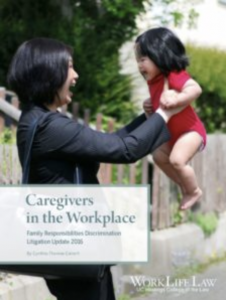
The vast majority of Americans will need to take time off work to care for family at some point in their careers, yet employers have largely failed to put in place policies that protect and support these caregivers. This is the main conclusion of Caregivers in the Workplace, a report by the Center for WorkLife Law. Based on a comprehensive review of more than 4,000 family responsibilities discrimination cases, it is the latest example of the center’s long-standing effort to improve workplaces by reducing bias against caregivers.
The report, written by WorkLife Law Key Affiliate and Workforce 21C Founder Cynthia Thomas Calvert, explains why caregiver discrimination happens, the impact it has on workers and businesses, and what employers can do about it. Here’s an easy-to-read summary of the report.
Help Us Research Bias And Support Improving Workplaces for All
Take a 5 minute survey to anonymously contribute to our Bias at Work project, an ambitious effort to create the largest national dataset on bias We will analyze all survey data, striving to release findings and tools that lead to effective actions to improve workplace climates.
Take the Survey
What is caregiver discrimination?
Simply put, caregiver discrimination happens when employees are treated unfairly because they care for family members. Bias against caregivers can be subtle or blatant, and it can happen to pregnant women, mothers and fathers who care for children, employees who care for aging parents or any family member who is responsible for the care of sick or disabled relatives. The term “caregiver discrimination” was coined by the Center for WorkLife Law to capture this constellation of discriminatory workplace practices that impact workers with family responsibilities. Legally, caregiver discrimination is used by the Equal Employment Opportunity Commission to cover the laws it administers (including sex, pregnancy and disability discrimination). To capture the broader range of discrimination against caregivers — like the Family and Medical Leave Act, state laws and local laws — we use the broader term Family Responsibilities Discrimination.
Why does caregiver discrimination matter?
American families and workplaces have changed dramatically in the past 50 years. “Ideal workers” — employees who are always available and never need to take a day off to care for family — are increasingly rare. In most American families, all of the adults work full-time and caregiving responsibilities must therefore be shared. Women still do most family caregiving and can be disproportionately affected by caregiver discrimination, but the number of men who experience FRD is on the rise. This is because modern men are taking a more active role in caregiving, whether that means raising their children or caring for aging parents. Beyond this, the population is getting older, leading to a significant increase in the need for eldercare.
Calvert observes that almost every employee will be a caregiver – a parent or a carer for an aging or disabled family member – at some point during his or her career. In the absence of clear policies, any of these people could find themselves at risk of caregiver discrimination. This is why caregiver discrimination matters.
Caregiver discrimination also has a significant influence on businesses, regardless of whether they are ever sued for discrimination. Companies and organizations that fail to address family responsibilities discrimination suffer with reduced productivity, decreased morale and lower employee retention rates; the harm this does to their reputation can also cause them to struggle with attracting new employees and new business. Taken together, all of these things affect employees’ ability to provide good customer service, and can have a direct impact on the bottom line. In short: Businesses with unchecked caregiver discrimination suffer.
Who is most affected by caregiver discrimination?
Family responsibilities discrimination can and does happen to people of every gender, ethnicity, national origin and race, in every sector of the economy, at every level of pay. Of the legal decisions reviewed, the majority (67%) were related to pregnancy and maternity leave (a situation that WorkLife Law has sought to remedy with its Pregnant@Work initiative, an online resource center that provides tools and educational materials about accommodating pregnant and breastfeeding women at work). Roughly 11% of legal decisions related to eldercare, while 9% related to the care of sick children and 6% to the care of sick spouses.
The Caregivers in the Workplace report looked at 4,000 legal decisions, but it’s important to note that researchers believe that this is just the tip of the iceberg, as many cases are settled out of court. People who work in management or business are significantly more likely to file suit than those in other occupations, however, researchers caution that this is likely a reflection of increased access to information and resources, rather than a reflection of who is more likely to suffer caregiver discrimination in the workplace.
Who wins? How much do courts award?
Overall, workers who sue their employers for caregiver discrimination win or settle their case about 52% of the time. In cases that go to trial, employees win 67% of the time; if the trial takes place in federal court, the win rate goes higher, to 75%. We can conclude from this higher success rate that employers simply are not recognizing and remedying caregiver discrimination in the workplace.
Workers who sue their employers recover an average of roughly $650,000. In some extraordinary cases, plaintiffs have been awarded over $1 million dollars. In one particularly grievous case, a single mother who was denied advancement and later fired was awarded $185 million. In all, employees recovered almost half a billion dollars in connection with caregiver discrimination cases between 2006 and 2015.
New Trends
Women who are pregnant or parenting are far more likely to sue for caregiver discrimination than any other group, which is why the Center for WorkLife Law created the Pregnant@Work initiative. However, researchers have noticed several new trends. Men are suing more often, in part because they are taking on more caregiving responsibilities. While the numbers remain small, there has been an increase in the number of women suing when employers fail to provide space to express breast milk (lactation accommodation) and when they are forced to do work that might compromise a pregnancy (pregnancy accommodation). Claims for elder care have also increased and now make up over 10% of all caregiver discrimination claims, making them the second most common type of claim.
Do I have a case?
Only a lawyer can provide you with legal advice. However, the WorkLife Law Family Responsibilities Discrimination Hotline is available to both employers and employees with questions regarding caregiver discrimination laws. The hotline is free to call and designed to inform workers and employers about their legal rights and obligations on issues pertaining to family caregivers, leave, and caregiver discrimination in the workplace. You can reach the hotline by calling (415) 703-8276 or by emailing hotline@worklifelaw.org.
How can I help address bias against caregivers in my workplace?
The Center for WorkLife Law has several resources that can help to support caregivers in the workplace. For employers, the Center has created a sample policy for employees with family caregiving responsibilities, and our Pregnant@Work initiative has developed a model pregnancy accommodation policy. Individuals and employers can benefit from our FRD Resources page, which includes links to our FRD Fact Sheet and FRD FAQ. We also have specific resources for men experiencing caregiver discrimination and for those who experience FRD while providing eldercare. Through the Women’s Leadership Edge program, the Center provides innovative, research-backed training programs for women leaders, the goal of which is to help organizations retain, support and advance women from within.
This article is based on Caregivers In The Workplace, a 48-page report issued by the Center for WorkLife Law based on a comprehensive review of more than 4,000 family responsibilities discrimination cases. You can read the full report here.
